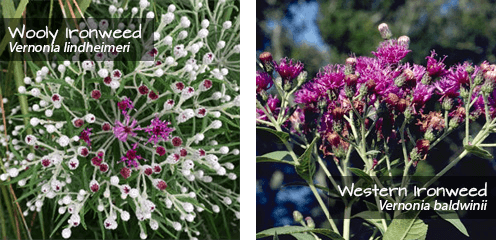The summer heat is brutal to ordinary blooming plants. But there are ironclad options that’ll show the scorch who’s boss — and add the color your landscape craves.
As the summer heats up, many flowers are shriveling and shrinking from the sun. But if you’re craving mid-summer color, there are some tough, hardy options available.
Wooly ironweed is the way to go. This native perennial thrives in direct sun or part shade and thin soils — and it’s sure to liven up any garden during the hottest months.
Wooly ironweed grows several stems each about 3 feet tall. In nature, it’s found in the rocky clays of the Hill Country, but can easily be grown in a variety of soils. The gray-green foliage provides interest in the spring and makes a great backdrop for shorter perennials like damianita or blackfoot daisy. Right when annual spring wildflowers are starting to droop, bright purple flowers in a showy umbel burst from the ends of each ironweed stem.
The bloom period of ironweed makes it an important plant for native pollinators. Spring and fall are times of relative abundance in terms of available blooms for nectar-seeking insects.
By planting summer-blooming plants like ironweed, you can help local pollinators make it through the tough summer months. Pair it with mealy blue sage and rock rose, other hardy summertime bloomers.
Western ironweed (Vernonia baldwinii) is another similar summertime nectar plant. It’s bigger, growing 5 feet or more in ideal locations, and likes deeper soils and shadier conditions.
I’ve always thought western ironweed would be a great complement a frostweed patch. Like frostweed, western ironweed is an aggressive colonizer so only plant it where it has room to spread.

Getting to know native plants, like ironweed, can help ensure there’s always something interesting happening in your landscape.
Show summer who’s boss. Plant some ironweed this fall.


